August 24th, 2011
This is part of a series on puzzle solving techniques. If you are stuck on a particular Krazydad puzzle, drop me a note, and I’ll use this space to help you out.
This puzzle is also from Margaret, who got stuck on a Tough puzzle (Tough #4 from book 40). If you’d like to try your hand at this puzzle, you’ll find the original here.
Here’s the puzzle at the point where Margaret got stuck.
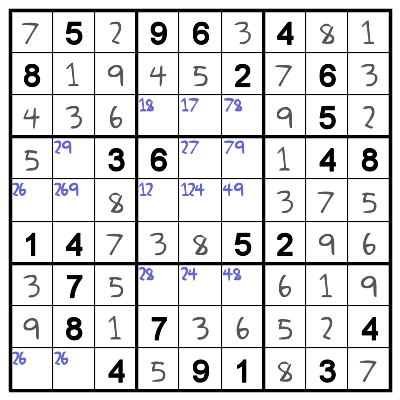
It looks nearly done, but the remaining cells look nearly intractable. Normally, I’d be tempted to just substitute in a value and see what happens, but there is a more logical way to approach it. It turns out there is an XY-wing lurking in there. You can read about the XY-wing technique here.
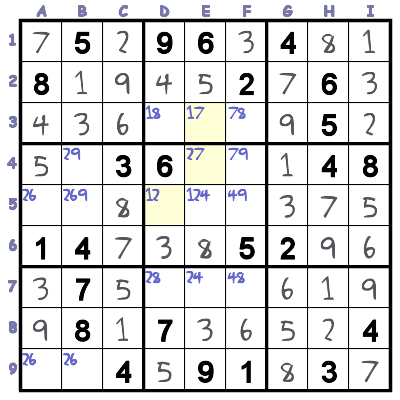
The root of the XY-wing is cell E4, which has 2 and 7 as possibilities. It is connected to cell E3 (which can be 1 or 7) and cell D5 (which can be 1 or 2). Think about the ramifications: If E4 is 2, then D5 must be 1. If E4 is 7, then E3 must be 1. Since E4 can only be 2 or 7, either E4 or D5 must be 1. This means that any cell that is simultaneously connected to both E4 and D5 cannot ever be 1 (because it would prevent both E4 and D5 from being 1).
This means we can clear 1 as a possibility from cells D3, and E5.
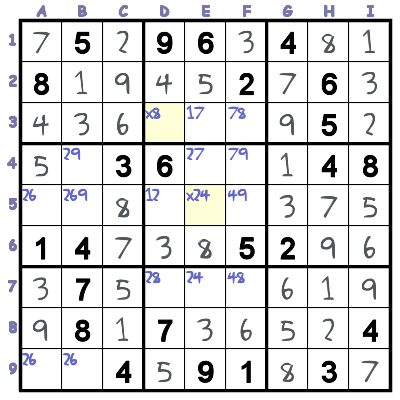
Both of these cells are connected to both E4 and D5. Once we’ve cleared the 1s out, it’s obvious that D3 must be 8. Now the rest of the puzzle solves easily.
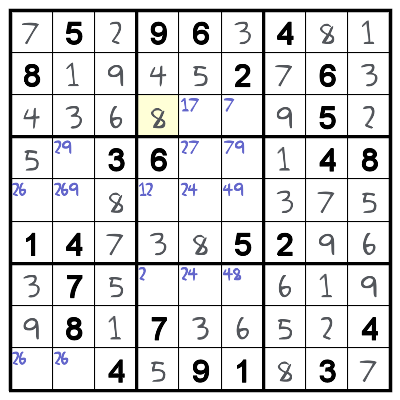
As it turns out, XY-Wing crops up pretty frequently in the Tough puzzles. In book 40 alone, puzzles 2,3 and 4 make use of it.
UPDATE: Stephen wrote me with an alternate breakthrough which makes use of the knowledge that the puzzle must have only one solution:
My wife Stella had an insight…
Looking at column B, assume B4 is a 9, then A5, A9, B5 and B9 all have the same possibilities and there would be two possible solutions; ergo B4 is not a 9 but a 2 and away you go.
Of course this is contingent upon there only being one possible solution…
Pretty clever!
Permalink | Comments Off on Sudoku Troubleshooter #2 – XY-Wing
August 23rd, 2011
Occasionally, I get mail from fans of the site who need help with a puzzle. I’ve decided to devote the next few blog entries to puzzle solving techniques. If you want help with a particular Krazydad puzzle (especially puzzles that are easier than “Super Tough”), drop me a note, and I’ll troubleshoot your problem too!
Our first puzzle is from Margaret, who got stuck solving the daily Challenging puzzle from May 12th. If you’d like to try your hand at this puzzle, you’ll find the original here.
Here’s the puzzle at the point Margaret got stuck.
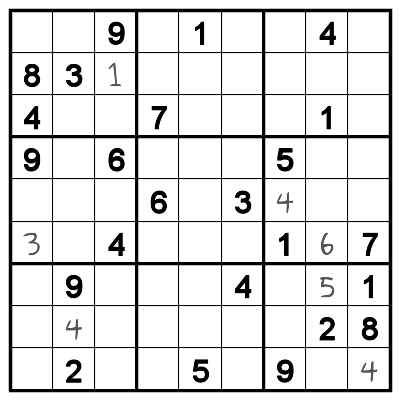
Looking at just the 1s, these appear to be possible squares for ones:
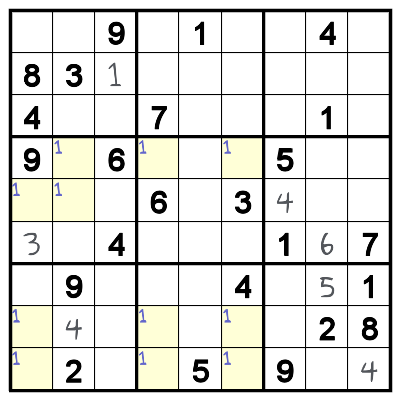
I’m gonna use the row/block and column/block technique to narrow them down further. Looking at the block on the lower left, I can see that the 1 in that block must occur in the first column.
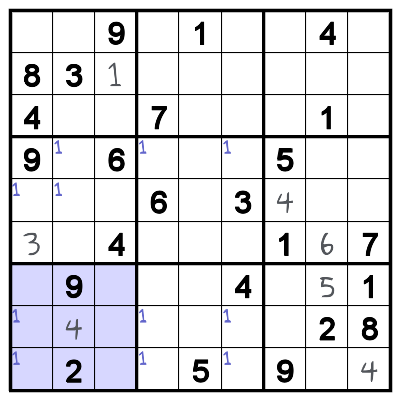
That means we can eliminate 1 from all the other squares in that column.
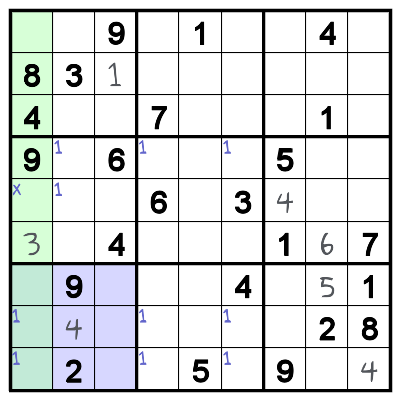
Now, looking at the center block, I can see that 1 must occur in that block in row 4. So I an eliminate 1 from other squares on row 4.
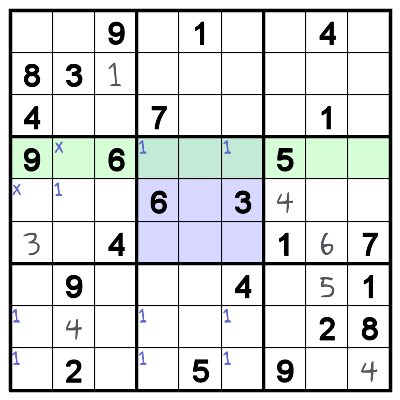
Now we’ve found a 1!.
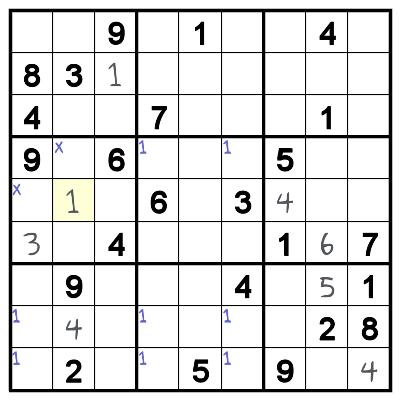
You can use the same type of logic to find a 2. Try it!
Permalink | 1 Comment »
March 6th, 2011

I know from your correspondence that many of you download my puzzles to keep your brains active and sharp. If this describes you, I think you’ll like the new book by Joshua Foer called Moonwalking with Einstein: The Art and Science of Remembering Everything
[ Self disclosure: I should mention that I once lunched with Josh, a young science journalist, some years ago in connection with my Athanasius Kircher project. He was the secretary of the then active Athanasius Kircher Society. We are both huge Kircher fanboys. ]
From the first few Amazon user reviews, you might be inclined to believe this is a self-help book for improving your memory. It can be viewed that way, but the book is actually an interesting piece of investigative science journalism combined with a memoir, that just happens to offer some useful techniques for remembering things.
Josh describes his yearlong journey from being a bright, nerdy, but otherwise normal guy living in his parent’s basement to being a finalist in the U.S. Memory Championship in 2006. Along the way we meet a fascinating cast of hucksters, eccentrics, scientists and savants.
As Josh trains his mind to do seemingly impossible things, he shares his techniques, such as storing hundreds of random factoids in a “memory palace”, and we practice along with him. At the same time, he takes us on a wonderful tour of classical approaches to memory training and reveals how the nature of externalization of memory (writing, printing and computers) has changed the way we thing about and use our brains over the centuries.
Josh provides a healthy dose of skepticism and debunks some commonly held myths like “photographic memory.” He has a fascinating encounter with a celebrated “savant” who may be less remarkable than he claims to be. In fact, most of the contestants we meet claim to be normal people who have trained themselves using an arsenal of specialized techniques for remembering things.
I love that the book offers hope to all of us who feel increasingly addled. When I was 20 years old, it didn’t bother me when I lost my keys. Now it does, and it is all too easy to blame it on aging. How welcome it was to read this passage:
My own memory was average at best. Among the things I regularly forget: where I put my car keys (where I put my car, for that matter); the food in the oven; that it’s “its” and not “it’s”; my girlfriend’s birthday, our anniversary, Valentine’s Day; the clearance of the doorway to my parents’ cellar (ouch); my friends’ phone numbers; why I just opened the fridge; to plug in my cell phone; the name of President Bush’s chief of staff; the order of the New Jersey Turnpike rest stops; which year the Redskins last won the Super Bowl; to put the toilet seat down.
Sound familiar? If this guy can memorize a deck of cards in under two minutes, so can you.
link
Permalink | 1 Comment »
January 13th, 2011
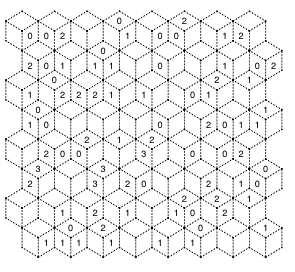 Fans of my variety slitherlinks will enjoy these two new sets of puzzles, based on two different Rhombille tilings supplied by reader Lars Huttar. Fans of my variety slitherlinks will enjoy these two new sets of puzzles, based on two different Rhombille tilings supplied by reader Lars Huttar.
The first set (shown here) is a basic rhombille tiling with intersections containing 3 and 6 vertices.
The second set contains intersections of 3, 4 and 5 vertices.
Rhombille Set #1 (six puzzles)
Rhombille Set #2 (six puzzles)
UPDATE: Here’s a full set of these puzzles, using the second tiling..
Permalink | 3 Comments »
January 8th, 2011
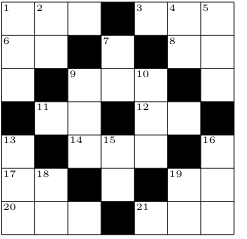 Here’s another crossfigure puzzle from one of our readers. Here’s another crossfigure puzzle from one of our readers.
This puzzle is by Paul-Olivier Dehaye, of the mathematics department at the Swiss Federal Institute of Technology. Thanks Paul!
Download the PDF
Do you have another good original puzzle to share? Let’s see it!

Permalink | Comments Off on A new crossfigure puzzle
December 23rd, 2010
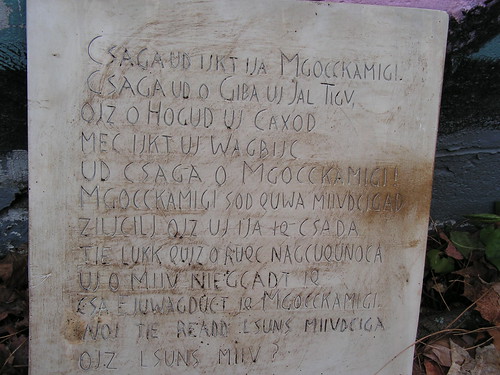
Rolf wrote in with the following message for the readers of KrazyDad:
Here is a link to a website that has photos of the large clay tablet unearthed recently by archeologists from the University of Brattleboro.
Here is a link to a photo of the tablet on Flickr.
The tablet, which measures 16 inches by 16 inches, has a mysterious message on it. Rumor has it that when deciphered, the message has a riddle on it, and that when solved, the riddle reveals a treasure that has been hidden in Brattleboro. However, anyone who solves the mystery can claim the prize, and travelling to Brattleboro, Vermont is not necessary, just fun.
There is no fee to enter a guess, but people who guess must write a short explanation of why they think their answer is correct. No explanation, no prize.
Thanks,
Rolf
I will add that if you solve the tablet, or the puzzle, please contact Rolf directly, and do not post the actual answer here – no spoilers!
Happy Solving!
Permalink | Comments Off on The Brattleboro Tablet
December 21st, 2010
Here is my estimate of worldwide Twitter volume since November 7th.
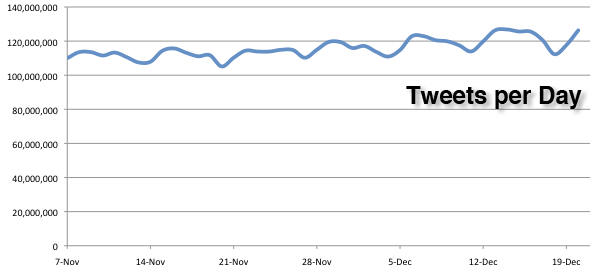
A few things to note:
* The growth in overall tweets per day has slowed a lot since the beginning of the year – it started to stall a bit in the autumn. Recent Comscore results show that visits to the Twitter website began to slow over the same period.
* My method for estimating tweets has changed since my last Blog post on the subject. On November 4th, Twitter rolled out a new ID numbering system called Snowflake that makes it impossible to estimate the rate of tweets simply by subtracting id numbers.
I came up with a new method for estimating Twitter volume that involves counting “collisions” in the id numbering system (these collisions are recorded in some of the bits of the new id numbers). The rate of collision rate is predictable given an underling twitter rate. Given a large enough sample, you can infer the twitter rate fairly accurately using an equation related to the well known “birthday paradox”.
If you’re a nerd, and would like more details about my method, drop me a note!
Permalink | Comments Off on Recent Twitter Volume
October 24th, 2010
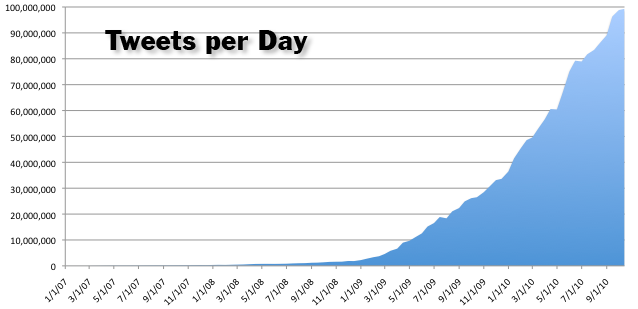
This weekend I compiled the data to produce the above graph, showing the level of activity on Twitter.
I figured this out using a commonly known method. Every tweet has a unique id number, for example the 20 that appears in the URL of this tweet which kicked off the service:
http://twitter.com/#!/ev/statuses/20
Assuming these id numbers are handed out sequentially, you can comparing the dates and id numbers of successive tweets to determine the rate that tweets are being created.
As it turns out, this method is a little tricky with Twitter, since there have been periods (such as most of 2007) in which Twitter incremented their ID numbers by 10, causing an apparent 10x increase in their volume. Perhaps this is why Tech Crunch misreported the daily tweet figure (for March of 2008), saying it was 3 million a day, when it was actually in the range of 400-600k.
On February 27th, 2008, Twitter went back to handing out sequential numbers. I suspect this was done to postpone the Twitpocalypse — the point at which the id numbers passed 2 billion, which might have caused problems with some Twitter clients that didn’t use enough bits to store the ID numbers. This eventually happened late on June 12th of 2009, but it would have happened a year earlier, if Twitter hadn’t gone back to sequential numbers.
When Twitter’s service goes down for maintainence (or other ranges), they often start back with an ID number which skips a big chunk, causing unrealistic spikes in the apparent tweet rate – they did this intentionally, for example, to trigger the Twitpocalypse a few hours early while employees were still awake. I’ve filtered out most of these spikes in the above chart.
The current Twitter volume is approaching 100 million a day, and has already exceeded it on a couple days this month.
Interestingly, we appear to be approaching a plateau, although it is still a little too soon to be sure (I can imagine myself thinking the same thing in July of ’09, and being quite wrong). The growth rate declined a bit this summer, and since Twitter started rolling out the “New Twitter”, it has declined more dramatically. I’m not sure if the New Twitter is a factor, or if Twitter is simply reaching a saturation point.
It will be interesting to see if Twitter manages to sustain another strong growth spurt in the coming months.
For comparison, here’s a very similar graph that Twitter produced a month ago, and here’s what Google has to say about visitors to Twitter’s website.
UPDATE:
On November 4th, Twitter switched to a new ID system called “Snowflake” that prevents ID counting in the manner I described above. The new ids contain a time stamp (in milliseconds), a machine number, and a sequence number. You
can still estimate the overall traffic by looking at the sequence numbers, since the amount of non-zero sequence numbers is proportional to traffic, however this method requires a larger sample of tweets to get decent accuracy.
Permalink | Comments Off on Twitter Volume since 2007
October 1st, 2010
A more individually tailored version of the famous 411 scam arrived in my inbox this morning. I thought I’d share:
From: customerservice@citibank-group.com
Date: Fri, Oct 1, 2010 at 12:18 AM
Subject: SUB: CUSTOMER INFORMATION
* Attention
The Genealogical database of our deceased customer Mr. Bill Bumgardner has revealed you as his family relative. Kindly confirm this to enable us facilitate our bank’s auditing process thus changing his account name to yours as the beneficiary. His account balance worth 3.2 million GBP has to be audited and account name changed to its beneficiary name in accordance to the inheritance laws of the United Kingdom
Your immediate response will be appreciated.
Regards,
__________________________________________________
Mr. Graham De Wet | Customer Service Department
Citi Private Banking Group| P.O Box 38889, London, UK
(Phone) +44-2070609334 Extension 1 | (Fax) +44 (0) 70929835899 | (E-mail) customerservice@citibank-group.com
Disclaimer:
This e-mail and any files transmitted with it may contain information that is proprietary and confidential to Citi Bank and is intended solely for the use of the individual or entity to whom it is addressed. Any disclosure, use, copying or distribution of information contained in this e-mail by any one other than the named addressee is prohibited. Any views or opinions presented in this e-mail are solely those of the author and do not necessarily represent those of the Bank.
Wow! Long lost deceased relative! Huge sums of money! Large commercial banking concern! If only it were true. I could buy that pony I’ve always wanted…
Permalink | Comments Off on Scam Email #2394
September 16th, 2010
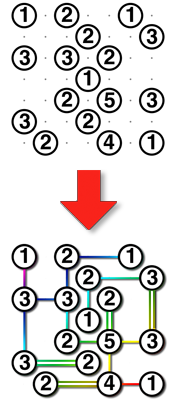 Hey folks, I’ve added some new Bridges puzzles to the site. In Japan, Bridges are known as Hashiwokakero which means “Bridge Building”. They are also known here as Hashi. Hey folks, I’ve added some new Bridges puzzles to the site. In Japan, Bridges are known as Hashiwokakero which means “Bridge Building”. They are also known here as Hashi.
In these puzzles, you are presented with a collection of numbered circles, which represent islands. You connect the islands with bridges to form a network of roads so that you can reach any island from any other island. The number on each island indicates the number of outgoing bridges. You may only connect islands horizontally or vertically, and you may use one or two bridges to connect islands, but no more than two. Each Bridge puzzle has only one unique solution, which you can find without guessing.
Fans of Bridges will probably also like the Galaxy and Slitherlink puzzles in my collection, which also involve spatial reasoning.
Bridges Puzzles
Permalink | 7 Comments »
|
|













 Here’s another crossfigure puzzle from one of our readers.
Here’s another crossfigure puzzle from one of our readers. 



